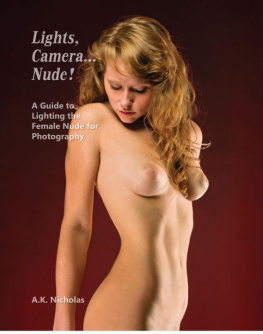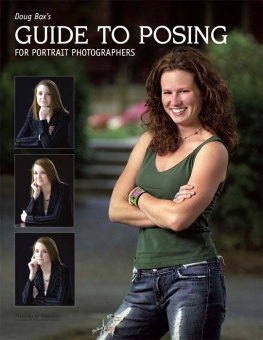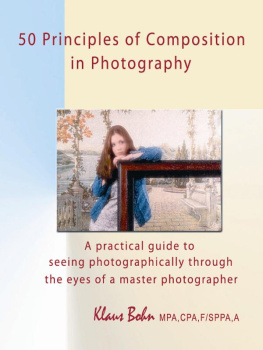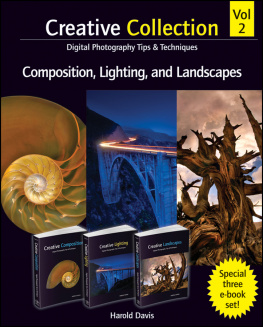
Exquisite Curves
Composition and Posing for Photographing the Female Nude
A. K. Nicholas
Editor: Anna Plesca
Interns: Traci Beilharz, Alyssa J. Baringer
Copyright 2012 A. K. Nicholas
All rights reserved. No part of this publication may be reproduced, stored in a retrieval system, or transmitted in any form or by any means, without the prior written permission of the copyright holder.
Published by Double Ink International
www.nudephotoguides.com
Kindle Edition
Limit of Liability/Disclaimer of Warranty: While the publisher and author have used their best efforts in preparing this book, they make no representations or warranties with respect to the accuracy or completeness of the contents of this book and specifically disclaim any implied warranties or merchantability or fitness for a particular purpose. Be aware that there are inherent hazards to the techniques described in this book, including but not limited to allergic reactions and electrical dangers. Exercise caution and plan ahead. Become aware of local laws before undertaking any activity in this book.
Special thanks to the models who appear in this guide: Jessica Anglin, Tawny Calhoun, Narza Crumbie, Nikki Dubose, Anna Faulling, Melissa Heidelberg, Sarah Hyder, Tess Irah, Victoria Irah, Gracie Jiles, Christi Kilgore, Lauren Keil, Elena Marie, Audrey Rose, Sara Right, Hope Splawn, Ariel Williamson, Elizabeth Winters.
Chapter Links

Preface
This guide is intended to be accessible to anyone with a serious interest in composition and posing of female nudes. You do not need to be an artist or a photographer to understand the material. It is written for the uninitiated and for those who have no more than a modest amount of experience with photography or composition. Although this book is primarily for the novice, intermediate academic concepts will also be included in condensed form. Since this guide does not teach basic camera technique, you will need to approach composition only after you have a basic proficiency with the craft. Experienced artists, whether they are students or professionals, will already have most, if not all, of the knowledge inside of this book.
The lines of the female form are a masterpiece of nature, as the title of this book implies. But, there are infinite ways to represent this beauty. Your job, as a photographer, is to create work that is appealing, fitting, and meaningful.
Thoughtful composition is what sets striking images apart from commonplace ones. It is a skill that draws your photography into the same realm as other mediapainting, drawing, and cinema. It is what makes a photographer more than a person who sets some dials and pushes some buttons.

Although there are still a few photographers formulating wonderful images with film, this book is written with the assumption that you are using a digital camera with interchangeable lenses. I recommend a camera that has manual controls for setting the shutter speed and aperture (f-stop). It does not need to be a top-of-the-line camera, for many professional photographers achieve superior results with less equipment than that of some well-equipped amateurs. Large amounts of expensive equipment may allow you to attempt a wider variety of techniques, but knowing what you want to create is what makes you a better photographer.
Photography is a subset of the broad context of visual communication. In this book, I will use the terms art and artist somewhat generically to mean any visual self-expression or one who creates such a visual presentation. Artist could mean a fine artist that produces works for display in an art gallery, or anyone with aesthetic intent. Whether you aspire to create beauty, glamour, pinup, or aesthetic nudes, this book should be relevant to your genre. However, I do make a distinction between a camera operator, who works merely as a technician to document reality, and an artist who expresses his or her viewpoint on the subject being rendered. The documentary photographer is careful not to inject a bias into his/her work, but this is exactly what an artist must do.
Composition is a mental process and you will learn that it has ties to psychology and the science of perception. Matters of equipment technique comprise the minority of this book, though I will discuss camera operation in the instances in which it intertwines with composition. The main thrust of this book is a discussion of the aesthetics of photographing models more than a discussion of the processes and science of photography. Perhaps the worst-suited person to ponder a composition is a photographer who is engrossed in f-stops, shutter speeds, and every other technique that went into creating the image. In order to analyze a visual statement, you cannot be consumed with thoughts about how it was constructed. More than with other media, photographers tend to be immersed in the technical process. Before you may see your work as others see it, you must put aside your analytical mind and let your creativity take the lead.
This book is written in a plainspoken style whenever possible. Recognizing that the audience for this book is broad and that some may want more detailed background, I will delve into academic or historic discourse at times, more deeply than it may be desired by all readers. I have distinguished such passages with a different font and color. Feel free to skim these more detailed passages. I descend into jargon, equations, and diagrams only where I find it unavoidable in order to do justice to the topics. However, the key points are always summarized for each area under discussion. This multipronged approach accommodates a variety of learning styles.

You will find a few exercises to help put what you learn to immediate use and to reinforce memory. Many of these require you to pick up your camera and find a model. Some of them, however, ask you to use a pencil and paper like a traditional artist. Before you shy away from such a task, you should know that the purpose of the drawing exercises is to open your mind to new ways of seeing and thinking that are broader than photography. There is no better way to learn this than with a pencil and paper. You do not need high-end art supplies; a couple of soft pencils and a sketchpad will work fine. If you own the digital equivalent, a pressure-sensitive graphics tablet and artists software, that will work just as well. It is inevitable that the methods and examples shown herein could be applied to general photography or media other than photography.
The most important ingredient to a figure photo is the choice of model, but the most ignored ingredient is composition. This is probably because composition requires serious effort and is not the fun part of nude photography. Trying to understand what makes an image feel right or look appealing in structured, repeatable ways can be a dauntingly academic undertaking. Composition is also one of the most misunderstood pursuits. Instead of being a set of hard-and-fast rules, it is a set of skills and, chiefly, a way of seeing. My experience is primarily with female models, so my writing and visual examples are from that point of view.
Next page










